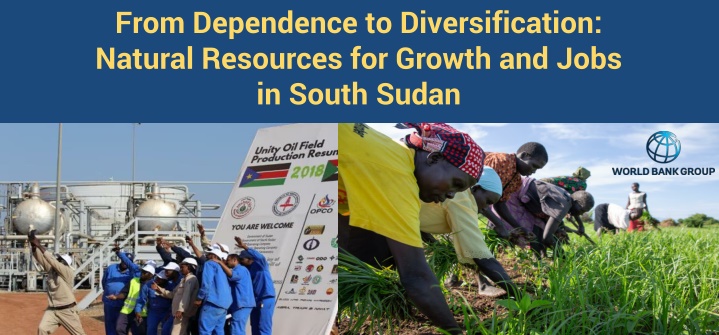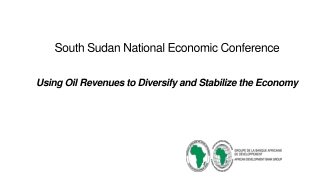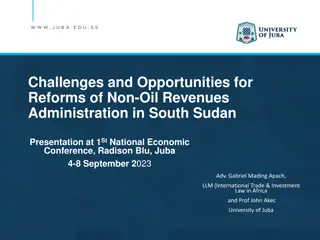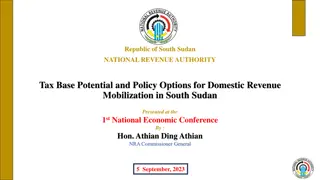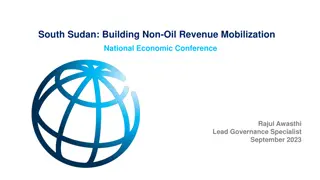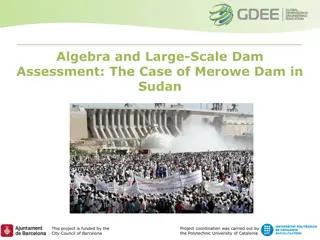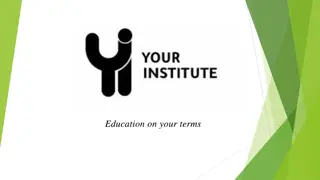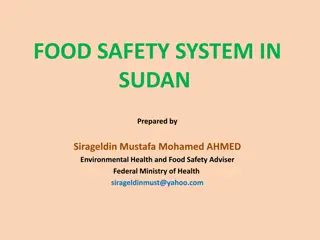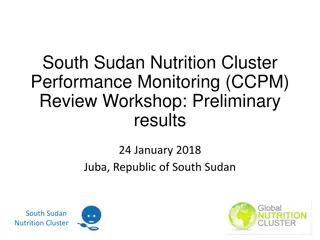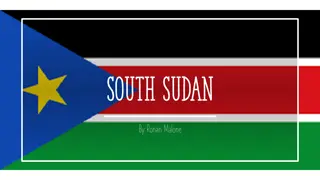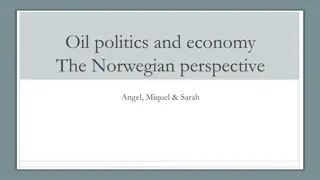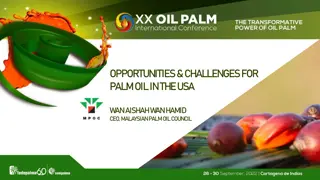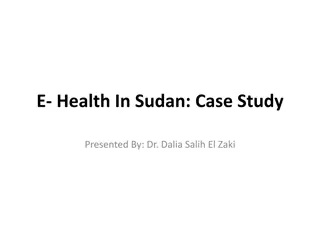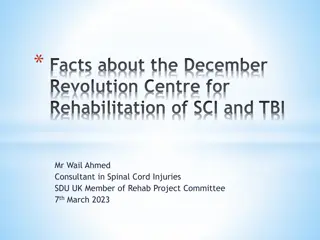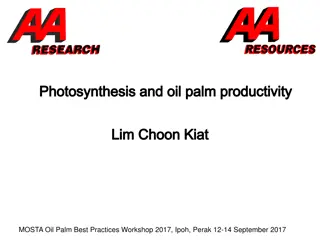Overcoming Challenges in South Sudan's Oil Economy
South Sudan faces the challenge of transitioning from oil dependence to diversification for sustainable growth. Despite having abundant natural resources, the country is plagued by poverty and limited development progress. The unfulfilled promise of oil, interrupted by various shocks, has hindered economic recovery post-civil war. Mismanagement and competition over oil resources further exacerbate the challenges. Reforms are needed to break free from the resource curse and pave the way for inclusive growth and job creation.
Download Presentation

Please find below an Image/Link to download the presentation.
The content on the website is provided AS IS for your information and personal use only. It may not be sold, licensed, or shared on other websites without obtaining consent from the author.If you encounter any issues during the download, it is possible that the publisher has removed the file from their server.
You are allowed to download the files provided on this website for personal or commercial use, subject to the condition that they are used lawfully. All files are the property of their respective owners.
The content on the website is provided AS IS for your information and personal use only. It may not be sold, licensed, or shared on other websites without obtaining consent from the author.
E N D
Presentation Transcript
From Dependence to Diversification: Natural Resources for Growth and Jobs in South Sudan 1
Outline 01. Why the urgency: The unfulfilled promise of oil 02. From dependence to diversification Principles and case studies 03. What will it take: Directions for reforms 2
1. Why the urgency: The unfulfilled promise of oil https://www.worldbank.org/en/country/southsudan 3
South Sudan is caught in a resource curse Despite abundant natural resources, poverty has risen and development gains are limited 2022 GDP per capita was among the lowest in the world, and South Sudan is falling behind GDP per capita, US$ Selected Development indicators, South Sudan 2500 KEN 2000 ZIM 2011 Most recent value South Sudan 90 82 80 1500 TZA 70 KEN 55 55 ETH 60 50 ZIM 50 UGA 1000 UGA 40 RWA TZA 30 RWA 500 20 7 South Sudan 4 4 3 10 ETH 0 0 Poverty Elect. Access (%) Life exp. (years) % of Land used for Agr 2011 2022 https://www.worldbank.org/en/country/southsudan Rate (%) Sources: IMF 4 Sources: World Bank, FAO
The unfulfilled promise of oil in South Sudan Post-civil war: economic recovery interrupted by multiple shocks (COVID-19, climate shocks, localized conflict, and global shocks) Oil reserves are 3rd largest in Africa, but oil production fell to the levels at independence due to civil war, flooding, and mismanagement of the oil sector GDP growth, percent 30 1000 bbl/day 20 Real GDP Oil Non-oil Oil reserves =3.5bn bbl 400 10 300 0 200 -10 100 -20 0 FY20 FY21 FY22 FY23 Average 2006-10 2022 Sources: IMF estimates, 2023 https://www.worldbank.org/en/country/southsudan Sources: IEA Oil Market Report, other 5
Challenges are amplified by competition over (and mismanagement) of oil resources US$mn (2022 Budget) % of GDP Distribution of the Government s oil revenue, FY22 Budget Diversion of oil resources heavily constraints spending on development (e.g., corruption, off-budget spending, repayment of oil-backed loans) Gross oil revenue Less direct/mandatory transfers Financial transfer to Sudan Transfer to Min of Petroleum (3%) Oil for roads Debt service (including repayment of oil advances) 1473 26.3 159.5 39.5 460 2.8 0.7 8.2 358 456 6.4 8.1 Net oil revenue to the Treasury Source: World Bank estimates Country Economic Memorandum (2022). Ministry of Finance, FY2021/22 Budget 6
Why the urgency to diversify: heightened risks (old and new) Macroeconomic reforms have begun but have further to go Old risks Crude oil price fluctuations (>90% of government revenues come from oil) Disruptions to oil production and exports Foreign exchange market reforms Improvements in PFM systems Non-oil revenue reforms Transparency measures Capacity building for better governance + Newer risks Climate shocks (flooding and droughts), locusts, subnational violence Oil resources to become stranded assets in the long term Sudan crisis 7
2. From Dependence to Diversification Principles and case studies https://www.worldbank.org/en/country/southsudan 8
Moving from below ground assets to above ground Focus on building above ground assets: human capital, physical capital, and institutional capital to underpin future wealth Manage revenue exhaustibility and volatility Manage trade-offs: how much to spend/save, what to spend on What is diversification? Are lower concentration of exports or production always more desirable? 9
Key lessons from the international experience Key lessons from the international experience .strong institutions to steer resource revenues into diversified assets (human, physical, institutional) Integrated approach to manage oil by and transparency and accountability A credible macro-fiscal framework that ties the hands of government More efficient and effective use of resource revenues in support of diversification Enhanced transparency in resource management, resource use and extractive sector Integrate oil revenue and oil funds into the budget process No parallel spending programs Insulate from volatility (e.g., fiscal rules) Publish detailed fiscal accounts, including data from resource funds and financial statements for public enterprises Save for difficult times and for future generations (e.g., Sovereign Funds) Strengthen PFM systems for a credible and accountable budget Gradually scale up spending for development considering what can be absorbed (mind capacity constraints) Strengthen treasury, accounting and audit procedures Improve public investment management to get value for money and resilience to climate shocks Fully implement the EITI Use resource funds to reinforce fiscal discipline, not as a separate policy tool Ensure that new borrowing does not compromise fiscal sustainability
Botswana: asset diversification (independence in 1966, current pop: 2.5mn) GDP per capita, US$ constant prices, PPP Successful at managing natural wealth Mining/Extractive sector, 2010s 2019 20,000 Prudent resource management, strong institutions Generous social sector spending used to accumulate/diversify financial, human and physical assets 80 15,000 60 10,000 5,000 40 0 20 1980 0 % of GDP % of exports % of FDI 2022 Less successful at economic diversification Diamonds continue to drive the economy, govt revenues and comprise 90% of goods exports, and extractives receive bulk of FDI Diversification hampered by large state footprint and monopolies, limited competition, import substitution policies Future diversification efforts aimed at shifting from mining minerals to mining knowledge
Timor Leste: building financial wealth and supporting development (independence in 2002, post-conflict country, current pop: 1.3mn) Petroleum Fund established in 2005 to preserve wealth for future generations and support use of oil resources for development Selected Development indicators 2002 59 2022 69 Between 2005-2021, $13bn transferred to budget to support development Life Expectancy (years) Govt spending on education (% of total) Govt spending on health (% of total) % of population in extreme poverty Income per capita, US$ constant, PPP Oil Sector (% of GDP) n/a 8 Economy has grown in sophistication, institutional capacity, life expectancy is up 10 years, and thousands lifted out of poverty 1.3 4.8 22 8 Petroleum Fund governance is among the best in the world. Demonstrates viability of strong institutional arrangements in post- conflict environment to support longer term development 2,392 4,640 95 70 12
Malaysia and Chile: successful export diversification State not only facilitated diversification, but shaped the direction of diversification by linking the extractives sector with the rest of the economy Rules-based macro management, leveraging oil/copper rents to support human capital and infrastructure Trade openness facilitated access to markets and integration into global/regional value chains Targeted human capital accumulation/ technical training/ R&D to support vertical & horizontal diversification Malaysia: oil, agr-> manufacturing Chile: copper -> high-value AGR products Share of exports (%) Share of exports (%) Manufacturing Agricultural raw materials Ores and minerals Agricultural raw materials Fuel Food Manufacturing Food Ores and minerals Fuel
2. What will it take Directions for reform 14
Leveraging natural capital requires peace, strong institutions, and prudent macroeconomic policies Peace Resilient Agriculture Sector Oil Sector Governance Institutions Macro Stability 15
Oil revenue investment options for South Sudan Oil sector governance Public capital Economic Transformation Accountability Transfers to households Governance Public capital + sovereign fund 16
Thank you www.worldbank.org/en/country/southsudan 17
